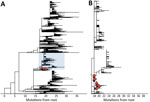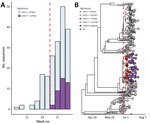Volume 28, Number 5—May 2022
Dispatch
Epidemiologic and Genomic Analysis of SARS-CoV-2 Delta Variant Superspreading Event in Nightclub, the Netherlands, June 2021
Abstract
We report a severe acute respiratory syndrome coronavirus 2 superspreading event in the Netherlands after distancing rules were lifted in nightclubs, despite requiring a negative test or vaccination. This occurrence illustrates the potential for rapid dissemination of variants in largely unvaccinated populations under such conditions. We detected subsequent community transmission of this strain.
Because of decreasing severe acute respiratory syndrome coronavirus 2 (SARS-CoV-2) incidence rates in the Netherlands at the time, the government of the Netherlands lifted most restrictions on June 26, 2021 (week 25) (1). The mandate to stay at home and get tested if experiencing symptoms remained. However, wearing of facemasks was no longer mandatory if a distance of >1.5 meters could be maintained. Event attendees who were fully vaccinated or had tested negative for SARS-CoV-2 within the previous 40 hours (testing-for-access) did not have to wear facemasks or maintain 1.5-meter physical distancing. Persons meeting 1 of those criteria (tested or fully vaccinated) were given a QR code in the CoronaCheck application, commissioned by the government of the Netherlands (2), which allowed them access to events.
Shortly after June 26, coronavirus disease (COVID-19) cases surged in the greater Amsterdam region of the Netherlands (Appendix 1 Figure 1). Most infections were among young adults 18–30 years of age (Appendix 1 Figure 2), of whom only 14% were fully vaccinated at that time (3). A steep increase in reported clusters related to the hospitality sector, particularly bars and discotheques, was observed in the following weeks; 121 clusters were reported in week 27 compared with an average of 4 clusters/week in weeks 21–25 (Appendix 1 Figure 3). To gain insight into the case surge and transmission dynamics, we investigated an outbreak linked to a nightclub event in central Amsterdam on June 26. We examined whether the high number of cases linked to the nightclub were the result of a superspreading event or the attendance of multiple infectious persons.
In the Netherlands, confirmed infections are reported to the local Public Health Service (PHS), and source and contact tracing is performed with a telephone interview. Data are obtained on sociodemographics, date of symptom onset, symptoms, vaccination status (and, if applicable, vaccine type, number of doses, and dates of administration) and locations the index-patient visited during the incubation and contagious periods. Medical ethics clearance for this study was not required (Appendix 1).
We defined a case as illness in a person who visited the nightclub on June 26, tested positive for SARS-CoV-2 within 14 days, and whose status was reported to the PHS. Cases were identified passively: persons were included only if they indicated during their PHS interview that they had visited the nightclub on June 26. The nightclub has an estimated capacity of 150 persons and was reported to be at full capacity that evening with attendees dancing and singing to loud music. A total of 60 confirmed COVID-19 cases were linked to the nightclub, raising suspicion of a superspreading event. Onset of symptoms occurred during June 27–July 3. Most case-patients were not fully vaccinated (defined as 14 days after completion of the vaccination series [Appendix 1 Figures 4, 5]): 4 (7.4%) persons were fully vaccinated and 41 (76%) were unvaccinated (Table). Most cases were in young adults (mean age 21.1 years [SD 3.3 years]) and women (60%), and most persons reported COVID-19–associated symptoms (93%). In 61% of cases, no other potential source for transmission besides the nightclub event was indicated. Of the 60 confirmed cases, 33 persons lived in the Amsterdam region and 27 resided in other regions (Table).
Samples from 23/60 cases were available for sequencing, of which 3 were not eligible because of high cycle threshold values (>32). For 19/20 samples, we successfully obtained full genome sequences; all belonged to PANGO-lineage B.1.617.2 (4), which was denoted as variant of concern Delta by the World Health Organization (5) (Appendix 1 Table). To provide for phylogenetic context, we included weekly surveillance samples from the Amsterdam region (n = 421) in the analyses, as well as all Delta variant sequences from the Netherlands available in the GISAID database (https://www.gisaid.org; n = 4,465) (Appendix 2 Table) on August 1, 2021. All nightclub-associated genomes showed characteristics of a superspreading event: a tight phylogenetic cluster closely related in time (June 27–July 3) (Appendix 1 Figure 4) and genomic diversity (Figure 1). The pairwise genetic distance between all sequences was <2 single-nucleotide polymorphisms (Appendix 1 Figure 6), comparable to previously observed superspreading events (6). In addition, all sequences formed a monophyletic cluster marked by a specific single-nucleotide polymorphism combination: a Delta variant with C4321T in the presence of (wild-type) 22792C. In our dataset, all viruses with this combination collected before July 1 were sampled from persons who were at the nightclub. This combination was not observed in our dataset or in any Netherlands Delta sequences (n = 4465) from the GISAID database before June 26 (Appendix 1 Figure 7). Furthermore, randomly collected surveillance samples in the region from the weeks preceding the nightclub event showed diverse viruses circulating in the Amsterdam region (Appendix 1 Figure 8), and samples collected from 2 other nightclubs on June 26 also showed different lineages (Appendix 1 Figure 9). This finding makes multiple introductions at the nightclub with a highly prevalent, highly similar variant unlikely. In all, these findings strongly suggest a single introduction of the C4321T + 22792C variant, which was amplified by superspreading at the nightclub.
Since the introduction of C4321T + 22792C, the variant has been increasingly detected in random genomic surveillance from the Amsterdam region: no surveillance samples were detected in week 26 compared with 33% of samples in week 28 (Figure 2). This lineage was introduced the weekend nightclubs were opened and has clearly propagated in the community, where subsequent transmission of the lineage occurred.
This study illustrates the amplification of a specific linage in a largely unvaccinated group under circumstances such as those observed in a nightclub where social distancing measures and facemask requirements were lifted, despite a testing-for-access policy. In addition, our results highlight the consequence of superspreading events on subsequent transmission dynamics of SARS-CoV-2 in the community. Investigating an outbreak on June 26, 2021, the first date that social distancing measures were lifted under testing-for-access conditions, enabled us to isolate a single SARS-CoV-2 transmission event.
The role of superspreading in SARS-CoV-2 transmission has been highlighted previously (6,7), also in the context of nightclubs (8,9). Considering the potential of SARS-CoV-2 to be transmitted through aerosols (10,11), nightclubs can be a high-risk setting because of poor ventilation and sustained overcrowding. Our findings suggest that the rapid surge in cases in July 2021 was at least partially driven by superspreading events such as the event we describe.
In particular, testing-for-access, as it was put in place in the weeks following June 26, provided opportunity for infectious persons to slip through. Access was provided immediately after a single Johnson & Johnson/Janssen vaccination (https://www.janssen.com) (too soon), a negative antigen test result was valid for 40 hours (too long), and checking of QR codes was reported to be inconsistent at some venues (12,13).
This study used data collected for nonresearch purposes during scaled-down source and contact tracing and has limitations. First, cases were passively included, which could underestimate the true extent of the outbreak, because asymptomatic cases or cases tested only by self-administered antigen tests might have been missed. This factor could also explain the high percentage of symptomatic cases (14). Nevertheless, we believe this factor did not result in a biased selection of cases. Second, we conducted genomic analysis for only 1/121 detected hospitality sector–related clusters, limiting generalizability of our findings.
In conclusion, testing-for-access did not prevent superspreading at this event, indicating the need for caution when easing social distancing measures in night life, even under more optimal testing-for-access conditions. This finding is particularly relevant in a population where vaccination coverage is low or when new variants circulate that are associated with lower vaccine effectiveness.
Mr. Koopsen is a PhD candidate at the Amsterdam University Medical Centre. His work focuses on the genomic epidemiology of SARS-CoV-2 and hepatitis C virus. Dr. van Ewijk is a public health physician in training, specializing in infectious disease control. She is also a fellow from the European Programme of Intervention Epidemiology cohort 2021 (European Centre for Disease Prevention and Control) at the National Institute for Public Health and the Environment.
ARGOS (Amsterdam Regional Genomic epidemiology & Outbreak Surveillance) consortium collaborators: Roisin Bavalia (PHS Amsterdam), Akke Cornelissen (PHS Amsterdam), Sylvia M. Bruisten (PHS Amsterdam), Catharina E. van Ewijk (PHS Amsterdam), Floor de Gee (PHS Amsterdam), Alvin X. Han (Amsterdam UMC), Maarten de Jong (Amsterdam UMC), Menno D. de Jong (Amsterdam UMC), Marcel Jonges (Amsterdam UMC), Norin Khawaja (PHS Amsterdam), Fleur Koene (PHS Amsterdam, Amsterdam UMC), Jelle Koopsen (Amsterdam UMC), Tjalling Leenstra (PHS Amsterdam), Mariken van der Lubben (PHS Amsterdam), Iris Mikulic (PHS Amsterdam), Sjoerd R. Rebers (Amsterdam UMC), Colin A. Russell (Amsterdam UMC), Janke Schinkel (Amsterdam UMC), Anja J.M. Schreijer (PHS Amsterdam), Judith den Uil (PHS Amsterdam), and Matthijs Welkers (Amsterdam UMC, PHS Amsterdam)
References
- Ministry of General Affairs. the Netherlands. The Netherlands takes a big step: almost everything is possible at 1.5 meters [in Dutch]. 2021 Jun 18 [cited 2021 Aug 1]. https://www.rijksoverheid.nl/actueel/nieuws/2021/06/18/nederland-zet-grote-stap-bijna-alles-kan-op-anderhalve-meter
- Ministry of Health. Welfare and Sport, the Netherlands. CoronaCheck [cited 2021 Aug 1]. https://coronacheck.nl
- National Institute for Public Health and the Environment. the Netherlands. COVID-19 vaccination program figures [in Dutch]. 2021 [cited 2021 Aug 1]. https://www.rivm.nl/covid-19-vaccinatie/cijfers-vaccinatieprogramma
- O’Toole Á, Scher E, Underwood A, Jackson B, Hill V, McCrone JT, et al. Assignment of epidemiological lineages in an emerging pandemic using the pangolin tool. Virus Evol. 2021;7:b064. DOIPubMedGoogle Scholar
- World Health Organization. Tracking SARS-CoV-2 variants. 2021 [cited 2021 Aug 1]. https://www.who.int/en/activities/tracking-SARS-CoV-2-variants
- Lemieux JE, Siddle KJ, Shaw BM, Loreth C, Schaffner SF, Gladden-Young A, et al. Phylogenetic analysis of SARS-CoV-2 in Boston highlights the impact of superspreading events. Science. 2021;371:
eabe3261 . DOIPubMedGoogle Scholar - Pozderac C, Skinner B. Superspreading of SARS-CoV-2 in the USA. PLoS One. 2021;16:
e0248808 . DOIPubMedGoogle Scholar - Muller N, Kunze M, Steitz F, Saad NJ, Mühlemann B, Beheim-Schwarzbach JI, et al. Severe acute respiratory syndrome coronavirus 2 outbreak related to a nightclub, Germany, 2020. Emerg Infect Dis. 2020;27:645–8. DOIPubMedGoogle Scholar
- Kang CR, Lee JY, Park Y, Huh IS, Ham HJ, Han JK, et al.; Seoul Metropolitan Government COVID-19 Rapid Response Team (SCoRR Team). (SCoRR Team). Coronavirus disease exposure and spread from nightclubs, South Korea. Emerg Infect Dis. 2020;26:2499–501. DOIPubMedGoogle Scholar
- Greenhalgh T, Jimenez JL, Prather KA, Tufekci Z, Fisman D, Schooley R. Ten scientific reasons in support of airborne transmission of SARS-CoV-2. Lancet. 2021;397:1603–5. DOIPubMedGoogle Scholar
- Centers for Disease Control and Prevention. Scientific brief: SARS-CoV-2 transmission. 2021 May 7 [cited 2022 Feb 10]. https://www.cdc.gov/coronavirus/2019-ncov/science/science-briefs/sars-cov-2-transmission.html
- Ministry of General Affairs. the Netherlands. Verbatim text press conference Prime Minister Rutte and Minister De Jonge (18 June 2021) [in Dutch] [cited 2021 Aug 1]. https://www.rijksoverheid.nl/documenten/mediateksten/2021/06/18/letterlijke-tekst-persconferentie-minister-president-rutte-en-minister-de-jonge-18-juni-2021
- Ministry of General Affairs. the Netherlands. Verbatim text press conference Prime Minister Rutte and Minister De Jonge (9 July 2021) [in Dutch] [cited 2021 Aug 1]. https://www.rijksoverheid.nl/documenten/mediateksten/2021/07/09/letterlijke-tekst-persconferentie-minister-president-rutte-en-minister-de-jonge-9-juli-2021
- National Institute for Public Health and the Environment. the Netherlands. Substantive substantiation of symptomology COVID-19 and consequences for tests and measures [in Dutch] [cited 2021 Aug 1]. https://lci.rivm.nl/onderbouwing-symptomatologie
Figures
Table
Cite This ArticleOriginal Publication Date: March 10, 2022
1These authors contributed equally to this article.
Table of Contents – Volume 28, Number 5—May 2022
| EID Search Options |
|---|
|
|
|
|
|
|


Please use the form below to submit correspondence to the authors or contact them at the following address:
Jelle Koopsen, Amsterdam UMC, Room K3-120, Meibergdreef 9, 1105 AZ, Amsterdam, the Netherlands; email:j.koopsen@amsterdamumc.nl
Top